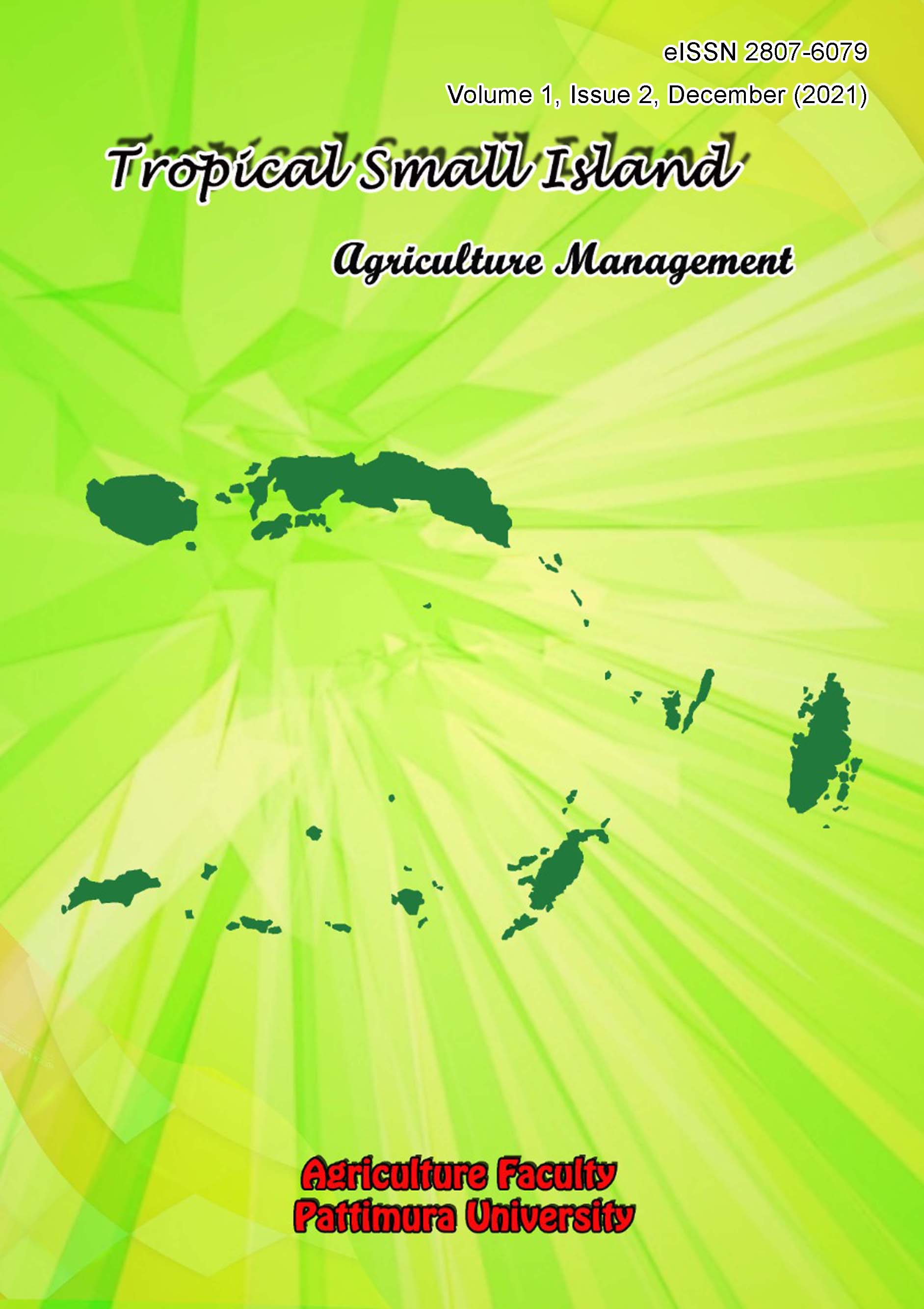Pengaruh Berbagai Konsentrasi Pupuk NPK Mutiara dan Jarak Tanam Terhadap Pertumbuhan dan Produksi Tanaman Kacang Tanah (Arachis hypogaea L.)
The Impact of Various Concentrations of NPK Mutiara Fertilizer and Planting Distance on the Growth and Production of Peanut Plants (Arachis hypogaea L.)
Abstract
This study intends to investigate how plant spacing and concentrations Mutiara NPK fertilizer affect the development and produce of peanuts (Arachis hypogaea L.). From February to April 2023, The Faculty of Agriculture at Pattimura University is where this study was conducted. This study, an experimental model with two components and a Randomized Group Design was utilized. The first element is the inorganic fertilizer concentration (P), which has three levels: 0 g (Control), 500 g NPK fertilizer/5 liters of water (starting solution), and 1000 g NPK fertilizer/5 liters of water (beginning solution). The second variable is the variation in planting distance with three distances: J1, J2, J3. The aforementioned treatments consisted of nine combinations that were run through three times to produce the 27 experimental units. Due to the interplay of a concentration of 1000 g of NPK fertilizer/5 liters of water and a planting spacing of 20 cm40 cm, a more significant number of plants leaves 27,8333 were produced, according to the study's findings.
Downloads
References
Badan Pusat Statistik. (2019). Maluku Dalam Angka Tahun 2018. Badam Pusat Statistik Maluku.
Fahmi, N. (2014). Pengaruh pupuk organik dan mutiara terhadap pertumbuhan dan hasil kedelai (Glycine max, L. Merril). Jurnal Floratek, 9, 53-62.
Harjadi, S. S. M. M. (1979). Pengantar Fisiologi Tumbuhan. Gramedia. Jakarta. 195 hal.
Hidayat, N. (2008). Pertumbuhan dan produksi kacang tanah (Arachis hypogaea L.). Varietas Lokal Madura pada Berbagai Jarak Tanam dan Takaran Pupuk Fosfor. Fakultas Pertanian Trunojoyo. Madura.
Jumin, H. B. (2005). Dasar-dasar Agronomi. Raja Grafindo Perseda. Jakarta.
Mamentu, M. Paulus, J.M. & Lengkong, E. 2018. Pemberian POC gamal terhadap pertumbuhan dan produksi padi sawah (Oryza sativa L.) dengan metode salibu. Eugenia, 24(1), 27-33.
Novizan. (2010). Petunjuk Pempukan yang Efektif. AgroMedia Pustaka. Jakarta.
Pitijo, S. (2009). Benih Kacang tanah. Karnius. Yogyakarta.
Ruhalena, W. (2021) Respon pertumbuhan dan produksi tanaman kacang tanah terhadap jarak tanam dan dosis pupuk NPK. Jurnal Agrida, 1(1), 49-57. https://ejournal.unida-aceh.ac.id/index.php/agrida/article/view/61
Sembiring, M., Sipayung, R. & Sitepu, F. E. (2014). Pertumbuhan dan produksi kacang tanah dengan pemberian kompos tandan kosong kelapa sawit pada frekuensi pembumbunan yang berbeda. Jurnal Online Agroekoteknologi, 2(2), 598607.
Suprapto, H.S. (2012). Bertanam Kacang tanah. Penebar Swadaya. Jakarta.
Tanaka, H., Kyaw, K.M., Toyota, K., & Motobayashi T. (2006). Influence of application of rice straw, farmyard manure, and municipal biowastes on nitrogen fixation, soil microbial biomass N, and mineral N in a model paddy microcosm. Biology And Fertility of Soils, 42(6), 501-505. https://doi.org/10.1007/s00374-005-0043-8
Yayang, N.A. & Heriyati H. (2014). Pengaruh Jarak Tanam dan Takaran Pupuk Kotoran Ayam terhadap Pertumbuhan dan Produksi Tanaman Kacang tanah (Arachis hypogaea L.). Volume: 84 – 88. Fakultas Pertanian Universitas Muhamadiyah Palembang.
Copyright (c) 2024 The Author(s)

This work is licensed under a Creative Commons Attribution-ShareAlike 4.0 International License.
Authors who publish with this journal agree to the following terms:
- Authors retain copyright and grant the journal right of first publication with the work simultaneously licensed under a Creative Commons Attribution License that allows others to share the work with an acknowledgment of the work's authorship and initial publication in this journal.
- Authors are able to enter into separate, additional contractual arrangements for the non-exclusive distribution of the journal's published version of the work (e.g., post it to an institutional repository or publish it in a book), with an acknowledgment of its initial publication in this journal.
- Authors are permitted and encouraged to post their work online (e.g., in institutional repositories or on their website) prior to and during the submission process, as it can lead to productive exchanges, as well as earlier and greater citation of published work (See The Effect of Open Access).









